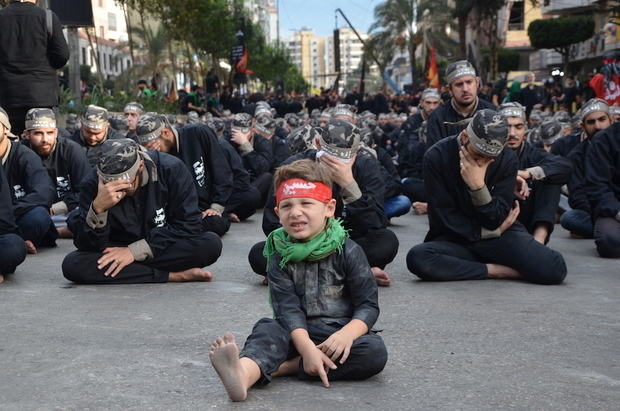Iran Ally Hezbollah Pays Syrian Rebels to Switch Sides
مقالة من ول ستريت جورنال: حزب الله الحليف الإيراني يدفع الأموال للثوار السوريين ليغيروا ولائاتهم
Sune Engel Rasmussen in Beirut and Suha Ma’ayeh in Amman, Jordan/The Wall Street Journal/November 03/18
Iran’s ally Hezbollah is paying former U.S.-backed rebels to switch sides and join a growing force in southern Syria, deepening its presence near Israel’s border after appearing to withdraw to avoid Israeli airstrikes, according to activists and a former rebel commander.
The Iran-backed militia has recruited up to 2,000 fighters, these people said, most of them from rebel groups that lost U.S. funding last year, according to the former commander, who tracks recruitment in villages in southern Syria.The Syrian government and its military ally Russia are depending on Hezbollah and other Iran-allied militias to fight the remaining armed opposition in the south, chiefly Islamic State.Israel, which views Iran as an existential threat, has warned it won’t allow forces loyal to Iran to entrench near its border.
Lebanon-based Hezbollah’s recruitment of fighters in southern Syria is “a highly destabilizing prospect,” said U.S. Syria Envoy Joel Rayburn. “The idea that Hezbollah would be expanding its presence down there on the Jordanian frontier, near the Golan Heights, near the Israeli frontier. This would increase the chance for conflict,” Mr. Rayburn said Friday during a conference in Manama, Bahrain.
The Pentagon didn’t comment when asked about on U.S. support for the opposition. “We are aware of regime and allied forces recruiting former opposition members in the wake of reconciliation agreements in Southern Syria,” Pentagon spokesman Cmdr. Sean Robertson said, referring to deals in which rebels ceded territory amid intensifying assaults by Russian and Syrian forces.The U.S. has said the removal of Iran-allied forces from Syria is a central goal for its 2,000 troops there and a precondition for allocation of funds to rebuild the war-ravaged country. The Trump administration is reinstating sanctions on Iran intended in part to force Tehran to halt its support for militant groups in the region.
Israel didn’t respond to a request for comment. Israeli officials in the past have said they are mostly aware of everything that happens in their backyard.
Early this summer, as Syria and its allies prepared to move against an antigovernment stronghold in the southwest, Iran appeared to move its militias away from the Israeli border to lessen tensions with Russia. Rebels later said that some militia fighters were donning Syrian army uniforms in an apparent effort to avoid further Israeli airstrikes against Iranian targets in Syria. Hezbollah declined to comment on its recruitment efforts in Syria. The Lebanese organization’s leader, Hassan Nasrallah, has said Hezbollah forces would stay in Syria as long as Syrian President Bashar al-Assad wants them there.
Hezbollah leader Hassan Nasrallah delivers a televised speech in June. He said his group would stay in Syria as long as the Syrian president wants them there. “Russia pushing Iran out is an illusion. It can’t rely on the Syrian army,” said the former rebel commander, who previously fought with the U.S.-backed opposition to Mr. Assad.
In a sign of further efforts to deepen its presence in the area, Iran in late October established a branch of a Shiite religious organization, al-Zahra, in the southern province of Daraa, following a visit to the area by a representative of Iran’s supreme leader, according to ETANA Syria, a civil society organization that monitors southern Syria.
For former rebels, joining Hezbollah provides a guarantee against arrest by the Syrian government. It also pays a $250 monthly salary, more than the Syrian army gives and compensation for lost income from U.S. support for their organizations. In June, the U.S. Embassy in Amman, Jordan sent WhatsApp messages to commanders in the south, saying they shouldn’t go into battle with the Assad government with “the assumption or expectation of military intervention by us.”
The U.S. withdrawal left the fighters feeling betrayed, the former rebel commander said. “Go to Russia, go to the regime, go to Iran—that was the message,” he said. The State Department didn’t comment on the message or U.S. support for rebel groups, but said, “We are aware of reports that regime and allied forces are recruiting soldiers in the area.”Israel has struck about 200 targets in Syria over the past 18 months, Israeli officials disclosed recently, both to block weapons shipments to Hezbollah and to prevent Iran from establishing a permanent military presence inside Syria, which would escalate the threat to Israel.
Iranian leaders see such a presence as an effective deterrent against Israeli and U.S. aggression on Iranian soil, according to a 2015 Pentagon assessment. Hezbollah’s recent moves in Syria’s south underscore the difficulty for Israel of rolling back Iranian influence.
Backed by Moscow’s air power and Tehran-allied fighters on the ground, Mr. Assad is reasserting control over most opposition-held territory in the country after a more than seven-year civil war. The Syrian government didn’t respond to a request for comment.
In June, Mr. Nasrallah said in a speech that Hezbollah is in Syria at the request of the country’s leadership. “We did not go to Syria with our own project,” he said.
Hezbollah doesn’t reveal its manpower on the ground in Syria. The group has around 25,000 full-time fighters altogether, according to an assessment by Jane’s. The U.K.-based Syrian Observatory for Human Rights estimates Hezbollah has recruited around 1,600 new fighters in Syria in recent months. But the former rebel commander said the number is closer to 2,000.
“Hezbollah and Iran understand that the winning game is the ground game: you need to embed yourself in communities, you need to build a presence and be part of the local economy and infrastructure,” said Emile Hokayem a senior fellow at the London-based International Institute for Strategic Studies. “It’s not just a headache,” Mr. Hokayem said about the situation in southern Syria. “Along with Lebanon, it’s going to be the fulcrum of the next conflict.”





















